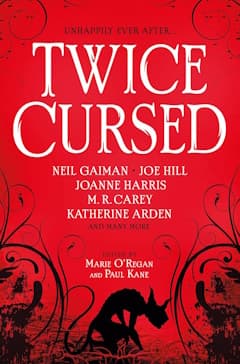
Twice Cursed edited by Marie O’Regan and Paul Kane
(Titan Books, 2023)
Reviewed by John Dodds
Ever wondered what happens to key characters in fairy tales after the main story has concluded or how they could be interpreted in other ways? Well, those stories form the main thrust (though not in every case) of the tales in this second volume of the Cursed series, Twice Cursed.
Given the available space, I won’t attempt to summarise and review all the stories herein, but I will try to capture some elements that I hope will engage your interest in reading what is an utterly compelling, disturbing, unusual, beautifully written anthology.
We kick off with short, sharp shock of a tale by Joanne Harris, “The Bell” about a woodcutter’s son with aspirations to change his life, but a rescue mission he undertakes has serious consequences: “Before you ring the bell…be sure to know what tune it plays”.
Two of the stories use a variant of the character of Snow White, giving her a contemporary slant. “Snow, Glass, Apples” by Neil Gaiman features an evil, blood drinking Snow White, a story I read some years ago, and of Gaiman’s usually high standard. Laura Purcell’s “Awake” considers beauty itself as a curse and asks some interesting questions about self-image and social pressures in a poignant yet dark way.
Being a fan of M.R. Carey, particularly his novel, The Girl With All the Gifts I had high hopes for “Mr Thirteen” and was not disappointed. The idea of unravelling (both physically and mentally), and a question of whether an unravelled body can be knitted or sewn back together, is bound into a tale that works as a thriller, a puzzle story and a genuinely scary piece of horror fiction.
Several tales tear to shreds a trope in some horror fiction, creepy dolls. “Pretty Maids All In A Row” by Christina Henry has a powerfully-disturbing central theme about a child-murdering man, and a wife who knew what he was doing but said nothing—the girl dolls in her collection gaze outwards to protect her from otherworldly revenge…until one of them loses and eye. “Just Your Standard Haunted Doll Drama” by Kelley Armstrong has a lighter touch, certainly with a creepy doll by considering the role of collectors and whether the spells on them can be lifted. “The Music Box” by L.L. McKinney features a young woman offering her support to an old woman in her town, and how she discovers a collection of music boxes with ballet dancers that are not mere dolls. And like the McKinney story, “Shoes as Red as Blood” by A.C. Wise, ballet dancing is used in a deeply disturbing way, poetically reworking the Andersen’s folk story, “The Red Shoes”.
“The Tissot Family Circus” by Angela Slater, “St. Diabolo’s Travelling Music Hall” by A.K. Benedict and “Dark Carnival” by Jo Hill take a fresh look at entertainments so beloved of holidaymakers, though with these particular examples, the punters might be less keen.
There is also an origin story from Clive Barker’s Hellraiser universe, “The Confessor’s Tale” by Sarah Pinborough, though neither the author nor the setting are specifically named.
In addition, we have a clever, engaging tale of what happened to the Ancient Mariner from Samuel Taylor Coleridge’s famous poem (again, not specifically referenced), “The Viral Voyage of Bird Man” by Katherine Arden.
Other great stories are, “The Old Stories Hide Secrets Deep Inside Them” by Mark Chadbourn, “A Curse is a Curse” by Helen Grant and (my personal favourite and perhaps the creepiest in the collection), “The Angels of London” by Adam G. Neville, which I felt has some echoes of the films, “Rosemary’s Baby” and “The Sentinel”.
Review from BSFA Review 22 - Download your copy here.
